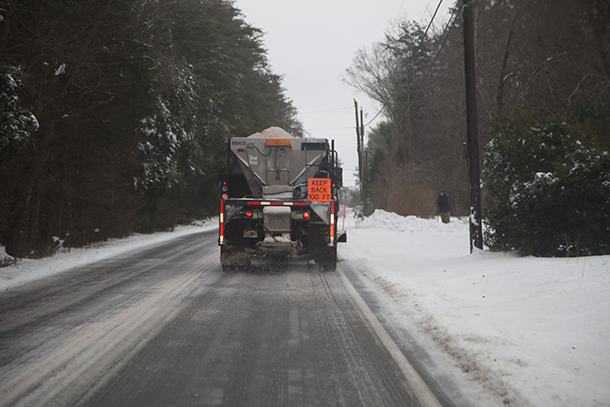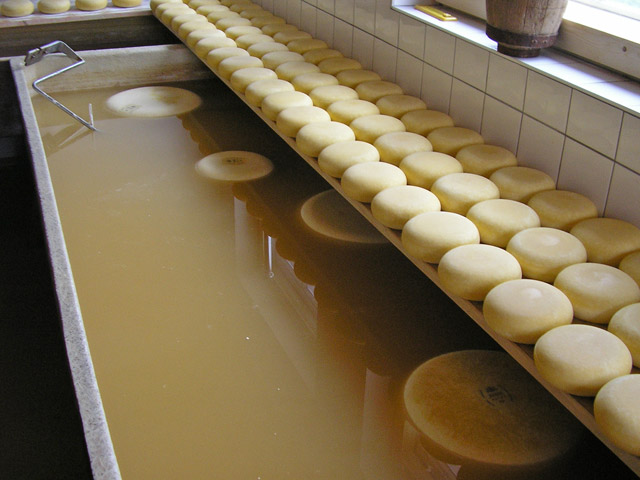Icy Roads Prescribed a Low-Sodium Diet
Air Date: Week of December 12, 2014

De-icing roads is crucial for keeping travelers safe, but commonly-used road salt can be harmful to the environment. (Photo: Virginia Department of Transportation; Flickr CC BY-NC-ND 2.0)
Road salt helps to melt ice and keep travelers safe but too much can harm the environment and wildlife. Living on Earth’s Jenni Doering reports that scientists are testing unusual salt alternatives including waste products from sugar beets, barley and cheese to cut the salt and keep roads clear.
Transcript
CURWOOD: Well, from sunny California we plunge into the kind of weather that many folks in more northerly parts of the US face in winter. Here’s this week’s note on emerging science from Jenni Doering.
DOERING: [SCIENCE NOTE THEME]
Winter in the north brings snow and ice – and tons of salt on roads. In Washington state, for example, road crews apply about four tons of salt per mile every winter – just for a single lane.
The salt certainly does the trick – it melts the ice, and makes it less likely to re-freeze – but there are both economic and environmental costs. Both the sodium and chloride ions in salt are toxic to plants and animals and accumulate in soils, streams, and groundwater. The ions also make cars rust and leach heavy metals from soils into the water supply. And salt on the roads attracts wildlife like deer and moose, causing deadly accidents. What’s more, sodium can get into drinking water and be harmful for people with high blood pressure.

Cheesemaking involves soaking the cheese in brine. In Polk County, Wisconsin, road crews add waste brine to road salt to aid in de-icing. (Photo: Sint Smeding; Flickr CC BY-NC-ND 2.0)
Now, universities are researching ways to put icy roads on a low-sodium diet. As well as experimenting with dried-out peonies, dandelions, and grass, they’re proposing to substitute industrial byproducts derived from beets, sugar cane, barley, and cheese, for some of the salt. These waste products are produced during sugar refining and cheese-making. Using them to help in de-icing ensures that they don’t go to waste, and reduces costs for road clearing, for example, Polk county, Wisc. is able to get cheese brine for free from a local dairy. The scientists some of these additives actually help lower the melting point of ice more than salt alone – a clear advantage keeping roads clear and travelers safe.
That’s this week’s note on emerging science. For Living on Earth, I’m Jenni Doering.
[SCIENCE NOTE THEME]
Links
What Happens to All the Salt We Dump on the Roads?
Communities seek a substitute for road salt
WSU researcher experiments with ‘green’ highway snow and ice control
Living on Earth wants to hear from you!
Living on Earth
62 Calef Highway, Suite 212
Lee, NH 03861
Telephone: 617-287-4121
E-mail: comments@loe.org
Newsletter [Click here]
Donate to Living on Earth!
Living on Earth is an independent media program and relies entirely on contributions from listeners and institutions supporting public service. Please donate now to preserve an independent environmental voice.
NewsletterLiving on Earth offers a weekly delivery of the show's rundown to your mailbox. Sign up for our newsletter today!
 Sailors For The Sea: Be the change you want to sea.
Sailors For The Sea: Be the change you want to sea.
 The Grantham Foundation for the Protection of the Environment: Committed to protecting and improving the health of the global environment.
The Grantham Foundation for the Protection of the Environment: Committed to protecting and improving the health of the global environment.
 Contribute to Living on Earth and receive, as our gift to you, an archival print of one of Mark Seth Lender's extraordinary wildlife photographs. Follow the link to see Mark's current collection of photographs.
Contribute to Living on Earth and receive, as our gift to you, an archival print of one of Mark Seth Lender's extraordinary wildlife photographs. Follow the link to see Mark's current collection of photographs.
 Buy a signed copy of Mark Seth Lender's book Smeagull the Seagull & support Living on Earth
Buy a signed copy of Mark Seth Lender's book Smeagull the Seagull & support Living on Earth

